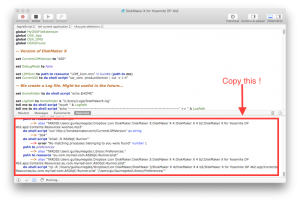

It’s all in Daylite: Clear up information overload. For a publisher, those bits of data can actually be useful for the end user, however, I’ve always wished there was an easy way for apps or extensions to “clean up” URLs and return the vanilla version of a link without any tracking parameter attached. I’m sure you’ve seen them too: it’s those ?utm and soc_src1 and similar strings of text that some web publishers rely on to monitor where traffic is coming from and track other parameters about clicked URLs. Then, you notice that the URL has a bunch of ugly tracking parameters appended to the end of it. You’ve just come across an interesting article or product you want to share with someone, so you copy the URL and you’re ready to send it over iMessage, tweet it, link it on your site – you name it. It’ll be missed.Įditor’s Note: Clean Up URLs and Remove Tracking Parameters with URL Cleaner is part of the MacStories Starter Pack, a collection of ready-to-use shortcuts, apps, workflows, and more that we’ve created to help you get the most out of your Mac, iPhone, and iPad. There’s nothing else like it on the market, and I’d like to thank Bill Cheeseman for his amazing work on this application over the years. Gruber argued that Apple should acquire UI Browser and make it part of their built-in scripting tools for macOS while I don’t disagree, I think it’s more realistic to hope another indie developer or studio picks up UI Browser and continues developing for as long as possible. Maybe it’s silly, but I think there’s something beautiful in the fact that the last thing I did with UI Browser was bridging the old world of AppleScript with the modern reality of Shortcuts.

I then mentioned UI Browser twice last month for Automation April: it was thanks to the app that I managed to create shortcuts to toggle the Lyrics and Up Next sidebars in the Music app for Monterey.

APPLESCRIPT CLEAN TEXT PRO
I first covered UI Browser in 2019, when I published a story on how I could control my Mac mini from the iPad Pro using Luna Display and some AppleScript, which I was able to learn thanks to UI Browser. UI Browser is both incredibly well-designed and well-named: it lets you browse the user interface of an app and copy the scripting syntax to automate elements of it. Arguably - but I’ll argue this side - “regular” AppleScript scripting is easier than “UI” AppleScript scripting, but “UI” AppleScript scripting with UI Browser is easier than anything else. The only downside: scripting the user interface this way is tedious ( very verbose) at best, and inscrutable at worst. They’re not APIs per se but just ways to automate the things you - a human - can do on screen.Ī great idea. UI scripting is, basically, a way to expose everything accessible to the Accessibility APIs to anyone writing an AppleScript script.
APPLESCRIPT CLEAN TEXT MAC OS
But as an expansion of accessibility features under Mac OS X, Apple added UI scripting - a way to automate apps that either don’t support AppleScript properly at all, or to accomplish something unscriptable in an otherwise scriptable app. If you ever merely tinkered with writing or tweaking AppleScript scripts, this is almost certainly what you know. Long story as short as possible: “Regular” AppleScript scripting is accomplished using the programming syntax terms defined in scriptable apps’ scripting dictionaries. Here’s what John Gruber wrote about UI Browser last week: UI Browser developer Bill Cheeseman, having turned 79 years old, has decided it is now time to “bring this good work to a conclusion”, and the app will be retired in October. UI Browser lets you discover the AppleScript structure of an app’s menu system, taking advantage of Apple’s Accessibility APIs to make it easier to script UI, which is not – how do I put this – normally “fun”, per se. You can open its dictionary in Script Editor to see what other things it can control.Longtime MacStories readers may be familiar with UI Browser, an incredible scripting tool for macOS created by Bill Cheeseman. ones that don't target specific applications). It's a special, background application that's useful for implementing system-wide scripts (i.e. >What is System Events? Is this part of the Mac OSX? Or by telling System Events where to send the keystrokes:īut this should be considered a last resort, only to be used if the application in question doesn't have a more direct way of inputting text. If you want to target a specific app you need to be more explicit in your script, either by ensuring the desired application is frontmost: You said you wanted the script to work anyway, so this script just blindly types the text. Instead, it appeared at the end of the script ran the script with an open AW6 document and kind of expected the text would appear there.


 0 kommentar(er)
0 kommentar(er)
